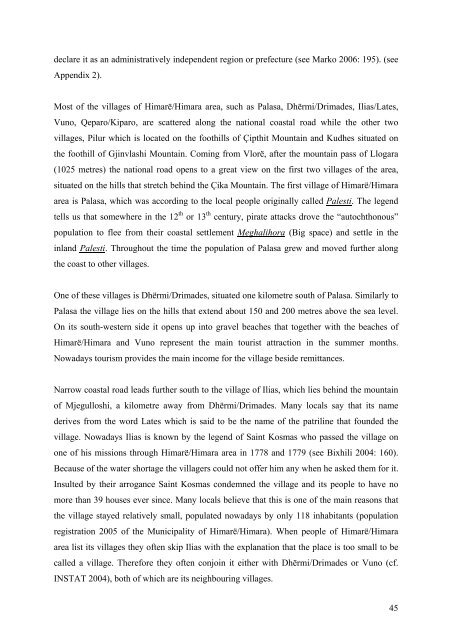university of nova gorica graduate school contested spaces and ...
university of nova gorica graduate school contested spaces and ...
university of nova gorica graduate school contested spaces and ...
Create successful ePaper yourself
Turn your PDF publications into a flip-book with our unique Google optimized e-Paper software.
declare it as an administratively independent region or prefecture (see Marko 2006: 195). (see<br />
Appendix 2).<br />
Most <strong>of</strong> the villages <strong>of</strong> Himarë/Himara area, such as Palasa, Dhërmi/Drimades, Ilias/Lates,<br />
Vuno, Qeparo/Kiparo, are scattered along the national coastal road while the other two<br />
villages, Pilur which is located on the foothills <strong>of</strong> Çipthit Mountain <strong>and</strong> Kudhes situated on<br />
the foothill <strong>of</strong> Gjinvlashi Mountain. Coming from Vlorë, after the mountain pass <strong>of</strong> Llogara<br />
(1025 metres) the national road opens to a great view on the first two villages <strong>of</strong> the area,<br />
situated on the hills that stretch behind the Çika Mountain. The first village <strong>of</strong> Himarë/Himara<br />
area is Palasa, which was according to the local people originally called Palesti. The legend<br />
tells us that somewhere in the 12 th or 13 th century, pirate attacks drove the “autochthonous”<br />
population to flee from their coastal settlement Meghalihora (Big space) <strong>and</strong> settle in the<br />
inl<strong>and</strong> Palesti. Throughout the time the population <strong>of</strong> Palasa grew <strong>and</strong> moved further along<br />
the coast to other villages.<br />
One <strong>of</strong> these villages is Dhërmi/Drimades, situated one kilometre south <strong>of</strong> Palasa. Similarly to<br />
Palasa the village lies on the hills that extend about 150 <strong>and</strong> 200 metres above the sea level.<br />
On its south-western side it opens up into gravel beaches that together with the beaches <strong>of</strong><br />
Himarë/Himara <strong>and</strong> Vuno represent the main tourist attraction in the summer months.<br />
Nowadays tourism provides the main income for the village beside remittances.<br />
Narrow coastal road leads further south to the village <strong>of</strong> Ilias, which lies behind the mountain<br />
<strong>of</strong> Mjegulloshi, a kilometre away from Dhërmi/Drimades. Many locals say that its name<br />
derives from the word Lates which is said to be the name <strong>of</strong> the patriline that founded the<br />
village. Nowadays Ilias is known by the legend <strong>of</strong> Saint Kosmas who passed the village on<br />
one <strong>of</strong> his missions through Himarë/Himara area in 1778 <strong>and</strong> 1779 (see Bixhili 2004: 160).<br />
Because <strong>of</strong> the water shortage the villagers could not <strong>of</strong>fer him any when he asked them for it.<br />
Insulted by their arrogance Saint Kosmas condemned the village <strong>and</strong> its people to have no<br />
more than 39 houses ever since. Many locals believe that this is one <strong>of</strong> the main reasons that<br />
the village stayed relatively small, populated nowadays by only 118 inhabitants (population<br />
registration 2005 <strong>of</strong> the Municipality <strong>of</strong> Himarë/Himara). When people <strong>of</strong> Himarë/Himara<br />
area list its villages they <strong>of</strong>ten skip Ilias with the explanation that the place is too small to be<br />
called a village. Therefore they <strong>of</strong>ten conjoin it either with Dhërmi/Drimades or Vuno (cf.<br />
INSTAT 2004), both <strong>of</strong> which are its neighbouring villages.<br />
45

















